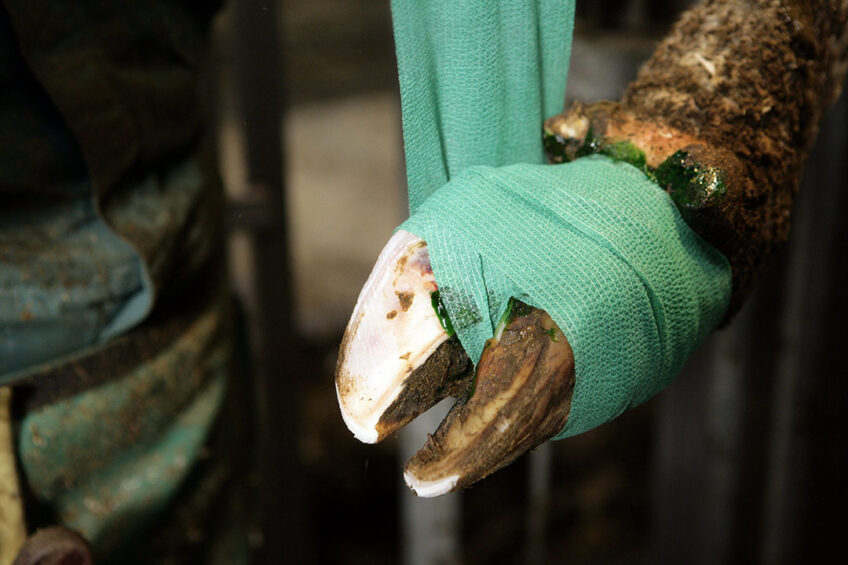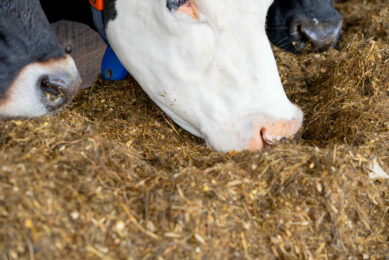Hoof health: 5 Prevention and control strategies

Hoof health problems are major issues in dairy cattle that can cause tremendous economic losses.
Depending on the severity, the following can be seen: decreased feed intake, BW loss, decreased milk production, decreased herd longevity and impaired reproductive efficiency. Prevention and control measures are important, but which measures can be adopted to minimise losses and improve animal production? Here are 5 strategies to control hoof health problems.

 Housing management
Housing management
House temperature
It is not uncommon to see an increase in lameness and other hoof problems 2 months after peak heat stress as a result of increased standing time during hot summer months. An east–west orientation will reduce solar exposure and alleviate many of these problems. Ventilation and cooling facilities should otherwise be provided during these periods. This will allow comfortable laying and relaxation of animals for several hours a day, improving blood circulation and activating the immune function to better cope with pathogen-induced hoof problems.
Cleaning
Overexposure to manure and urine can erode heels, so feeding areas and alleys should always be kept clean to prevent this problem.
Stocking density
Overcrowding often increases the negative effects of social interactions, especially with younger, less dominant cows or heifers, as dominant cows will displace low ranking cows from the stalls which forces them to stand for long periods. Plenty of space should be provided so that the less dominant cows have an escape route and don’t get trapped, then panic and injure themselves in the process of fleeing.
Flooring
In a study conducted at the University of Hohenheim in Germany, it was found that covering barn floors with sheets of soft rubber to mimic pasture soil helps to achieve the following advantages compared to solid concrete floors:
1. The soft ground acts as a shock absorber and thus maintains the integrity of the animal’s hooves. Although the animal has a natural substance resistant to shocks – the fat layer between the hooves – these fats are not sufficient to achieve this purpose, especially in high-yielding cows that consume the fat below the footpad, among other body fat sources, for milk production. This should prompt the provision of soft rubber sheets to suppress shock of barn floors.
2. It was found that the provision of soft floors allows unrestricted movement of the animal inside the barn. The distance travelled by the animal in one step can reach 78cm on soft floors but only 58cm on hard concrete floors. Such unrestricted movement helps improve blood circulation in the living tissue of the animal’s hooves, thus providing more protection for the hooves and increasing the ability of their outer edges to carry the bulk of the animal’s weight (60%) while walking.

 Nutrition
Nutrition
Since hooves are composed mainly of protein and fats, it is obvious that animals must receive adequate levels of both crude protein and fatty acids. Fermentable carbohydrates should be used in limited amounts in cattle feeding, or the rumen microbes that produce lactic acid increase and the pH is reduced. As the rumen pH decreases, endotoxins can be produced and released which can trigger histamine release. This causes vasoconstriction, dilation, laminar destruction and hoof deterioration, and the laminitis process develops. Rapid diet changes can also cause a shift in rumen microbial populations, which may favour species such as Treponema, which play a role in digital dermatitis. By carefully formulating the diet and monitoring cow health, the occurrence of poor hoof health can be minimised.
 How to keep cow hooves healthy
How to keep cow hooves healthy
Hoof health is important in all stages. When it comes to rearing youngstock it’s important to consider that healthy hooves are the foundation for healthy animals.
Mineral nutrition also plays a vital role in hoof health. Calcium is required to activate the enzyme needed to form keratin and is also required for the process of creating crosslinks between keratin fibres. Zinc is especially needed for cows with digital dermatitis infections or other lameness events. Zinc is very important for hoof growth and maintenance. It is an essential mineral in the formation of keratin and also influences calcium usage by the body. Copper is critical in forming crosslinks in the keratin that keep the hoof strong and hard. It is very important though to balance dietary copper and zinc, because too much zinc prevents proper copper utilisation and storage in the cow’s body.
Vitamins A and D play a role in hoof growth and help maintain a waterproof barrier on the outside of the hoof. Biotin, one of the B vitamins, is also important in hoof health. Providing 20mg/day of supplemental biotin has been shown to cure sole ulcers quicker, reduce sole haemorrhages and reduce the incidence of interdigital dermatitis.
 Dairy cows benefit from fatty acids in early lactation
Dairy cows benefit from fatty acids in early lactation
Research from Michigan State University (US) shows that fatty acid supplementation through early lactation significantly improves cow productivity.
 Grazing tips
Grazing tips
• Hoof infections are more common where pastures are on underlying clay than in sandy, chalky or limestone areas. Constantly wet hooves become soft and more easily damaged. Muddy ground with flints or small stones is the most dangerous since flints penetrate the hoof and allow infection to enter. Susceptible animals should be prevented from grazing these pastures.
• Susceptible animals should also be prevented from grazing tall fescue pastures because of the elevated level of the toxin ergovaline, which causes fescue foot condition. The condition is more apparent in cold seasons and is characterised by lameness, swelling around the fetlocks, pain and eventual loss of hooves caused by dry gangrene.
• Cross-infection of Dichelobacter nodosus, which causes foot rot, does occur between sheep and cattle grazing on the same pasture. Cows affected by D. nodosus may only have a mild skin infection that can be easily treated with drugs. In other cases, however, the infection may be too severe to be treated and D. nodosus can survive for long periods in the hooves of cows. It is important to take account of this when implementing mixed grazing programmes.
• Under poor grazing conditions, cows must spend time walking to search for food, which causes changes in gait over time with resulting hoof damage. With good-quality pastures, cows can show rapid improvements in gait due to the relatively short time of grazing.
 Increase pasture use: Steps to success
Increase pasture use: Steps to success
Here we dive into the latest findings on how to increase use of pasture and explore and face the challenges that come with it.
• Pasture may provide the animals with sufficient nutrients to maintain their body weight. However, in 95% of cases pasture may not contain sufficient amounts of elements such as copper and zinc, which are needed to maintain immune function and hence prevent bacterial infection of the hooves, particularly so in a period of very rapid pasture growth during spring. Supplementary feeding of these elements should be considered in these cases.
• As indicated above, high intake of rapidly fermentable materials (7.5–12.5g/kg BW) can reliably produce hoof problems even in genetically resistant animals. In this case, it is recommended to turn animals out very late at night or very early in the morning because the fermentable carbohydrate levels are likely to be at their lowest at these times.
• Cold temperatures reduce grass growth, resulting in the accumulation of rapidly fermentable carbohydrates. Therefore, animals should not be turned out onto pasture that has been exposed to low temperatures in conjunction with bright sunlight, such as occur in the autumn after the autumn flush of growth or on bright, cool winter days.
 Footbathing
Footbathing
Copper sulfate is commonly used in footbath solutions at a concentration of 2–5%. It decreases both the incidence and severity of hoof lesions and is relatively inexpensive. Formalin footbaths have many similar effects on hooves and are also inexpensive. However, formalin is a suspected carcinogen and must be used in a well-ventilated area and requires additional safety precautions. Formalin treatment concentration should be 3–5%. Chemical burns in cattle may be caused by the use of formalin solutions in excess of 5%. Zinc sulfate is another material used in the footbath solution at a concentration of up to 20%. Unlike the other footbath solutions, zinc sulfate has not been widely accepted because of difficulty dissolving it in water.
Footbath solutions should be maintained at a minimum depth of 10cm so dewclaws are duly submerged. The solution should be changed after 200 cows pass through the footbath. If cows have quite clean hooves and legs, the solution can be changed after 350 cows have passed through the footbath. If cows have dirty hooves and legs, the solution should be changed more frequently.
 New treatments for digital dermatitis
New treatments for digital dermatitis
Whilst scientists and product developers still do not know all the details about the causal organisms of this persistent disease, treatments are evolving.
 Trimming
Trimming
Correctly trimming a cow’s feet can give the hoof stability and enable the cow to distribute weight equally between the hooves. It is recommended to trim feet at least once or twice a year. The ideal times would be once at dry-off and again around 100 days in milk. A professional hoof trimmer who uses the correct equipment and procedures should be employed. Good record-keeping is key to monitoring a cow’s condition.
References are available from the author upon request.
Join 13,000+ subscribers
Subscribe to our newsletter to stay updated about all the need-to-know content in the dairy sector, two times a week.










